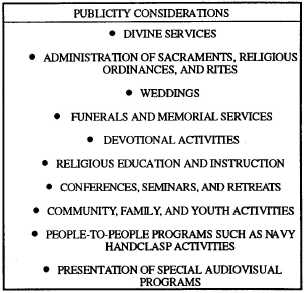screen. Determine the screen size you should use by
judging the distance from the screen to the most
remote viewer. The placement of the screen will vary
with the need to position other required items, such
as a chalkboard or an easel. After you have
determined a tentative position for the screen, project
an image on the screen and check the view from
different parts of the room to make sure everyone will
be able to see clearly.
Sound Level.— In an audiovisual presentation,
the sound level is just as critical as the visibility. A
sound level that seems loud enough during a practice
session may be entirely too low with a room full of
people. To accommodate the acoustic effects resulting
from the number of people in the viewing area, adjust
the sound level at the beginning of the presentation.
Special
Techniques.—
Some
special
techniques you can use that may go unnoticed by the
audience but will add to the effectiveness of the
presentation are (1) providing a sharp focus of the
projected image; (2) filling the screen with the image;
(3) preventing abrupt light changes; (4) avoiding
unpleasant sounds; and (5) fading the picture.
Safety Concerns.— Finally, as one of your
most important concerns, pay attention to safety
matters. Make certain you use and check for the
following safety guidelines:
Tape cords down with masking tape or cover
them with a piece of carpet to prevent people from
tripping.
When people walk or sit near the electrical
outlet, ask them not to jar the plug.
Tie the extension cord to the table leg so that
the equipment will not be pulled to the floor if the
cord is kicked.
Use three-wire adapters. Do not break the
third wire prong from a cord.
Do not use frayed or cracked cords.
Make sure the cord is large enough to
operate the equipment without heating up.
When several pieces of equipment are
involved, use a pigtail. The pigtail is better than
stringing several extension cords together.
Have a spare lamp available and practice
changing it. Never handle a new lamp with your bare
hands. The oil from your hands will cause the glass to
heat unevenly and shorten the life of the lamp..
Do not use unsturdy, makeshift tables to
hold equipment.
In addition to the actual setup, your
responsibilities for setting up will include looking at
the total environment—heat, lights, and ventilation.
Remember, your duties in support of an event will
continue until the event is over and the people have
left. If something should happen in the middle of a
presentation or service, you must be alert to detect
and correct the problem. This cannot be done if you
are sitting in an office while problems are surfacing
in the sanctuary or fellowship hall.
PUBLICITY
Publicity is an important tool of the CRP. Lack of
publicity may prevent the CRP from meeting the
needs of the command and the people for whom it
exists, Navy and Marine Corps service members and
their families.
Goals
Each CRP must develop its own
publicity
program, determine specific goals and objectives to be
met, and work out the methods to reach these goals.
Your responsibilities will require you to work closely
with the local Navy or Marine Corps public affairs
office (PAO) to spread religious program information
and carry out your CRP’s publicity goals.
First, you must work with the chaplains to
determine what activities and events require
publicity. An accurate idea of the nature, purpose,
and goals of a particular RMF activity—whether
religious or secular—will help you determine the type
of publicity that should be used. Figure 2-17 outlines
some religious, community, and family activities that
may require publicity.
Figure 2-17.—Religious, community, and family
activities to be considered in publicity programs.
2-26

